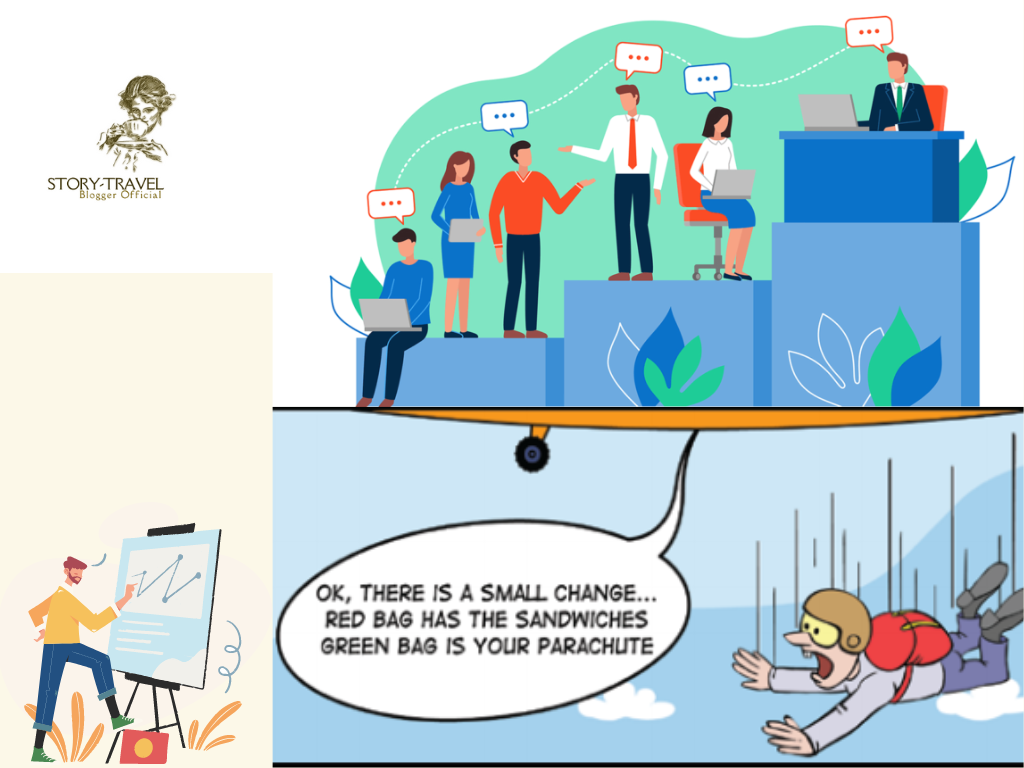Table of Contents
I. Introduction
Project Communication Management is a critical aspect of successful project execution. Effective communication lays the foundation for seamless collaboration, ensuring that all project stakeholders are on the same page and understand their roles and responsibilities. It involves the timely and accurate exchange of information, ideas, and feedback among team members, clients, vendors, and other stakeholders. In this blog, we will delve into the significance of communication in project management, explore the key components of Project Communication Management in the context of the PMP (Project Management Professional) certification, and highlight its impact on project success through real-life examples.

A. The Significance of Communication in Project Management
Effective communication is the lifeblood of any project. It acts as a conduit that facilitates the flow of information, promotes understanding, and builds strong relationships among project stakeholders. Without clear and open communication, projects can face a multitude of challenges, including misaligned objectives, missed deadlines, and unresolved conflicts. On the other hand, when communication is efficient, teams collaborate seamlessly, risks are identified and mitigated promptly, and decisions are made with informed consensus.
Example: Consider a software development project where the project manager communicates the project’s scope, timelines, and potential risks to the development team and the client. By maintaining clear communication channels and addressing any concerns promptly, the project stays on track, and the final product meets the client’s expectations.
B. Overview of Project Communication Management Knowledge Area in PMP
In the Project Management Professional (PMP) certification, Project Communication Management is one of the ten knowledge areas outlined by the Project Management Institute (PMI). It involves processes that aim to establish effective communication strategies, ensure the appropriate dissemination of information, and manage communication-related challenges within a project. The knowledge area comprises planning, executing, and controlling communication activities to keep all stakeholders informed and engaged throughout the project lifecycle.
Definition: Project Communication Management involves identifying stakeholders, determining their communication needs, defining communication channels, and establishing a Communication Management Plan to ensure the timely and accurate flow of information.
Example: During the initiation phase of a construction project, the project manager identifies the key stakeholders, such as the client, project team, contractors, and regulatory authorities. They then create a Communication Management Plan that outlines the frequency, medium, and content of communication for each stakeholder group.
Key Components of Project Communication Management
- Identifying Stakeholders: Recognizing all individuals and groups with an interest in the project’s outcomes and ensuring their needs are met through effective communication.
- Planning Communication: Formulating a Communication Management Plan that defines the information flow, communication frequency, and responsible parties.
- Executing Communication: Implementing the Communication Management Plan and delivering information to stakeholders as per the defined strategy.
- Managing Communication Challenges: Addressing communication issues, resolving conflicts, and adjusting communication approaches as necessary to maintain project alignment and harmony among stakeholders.
- Monitoring Communication Performance: Regularly assessing the effectiveness of communication strategies and making necessary improvements to enhance project outcomes.
By recognizing the significance of communication in project management and understanding the key components of Project Communication Management in the context of the PMP certification, project managers can build strong communication frameworks to ensure project success and stakeholder satisfaction.
C. Why Effective Communication is a Key Success Factor in Projects
Effective communication plays a pivotal role in the success of any project. It fosters collaboration, aligns project teams, and enhances the overall project experience for stakeholders. Here are some reasons why effective communication is a critical success factor in projects:
- Clarity of Objectives: Clear communication ensures that all project participants understand the project’s goals, scope, and objectives, reducing the risk of misinterpretation and confusion.
- Stakeholder Engagement: Effective communication engages stakeholders at every stage of the project, ensuring their perspectives are considered, and they feel valued in the decision-making process.
- Timely Risk Management: Open channels of communication allow for the early identification and resolution of potential risks and issues, preventing them from escalating into major problems.
- Scope Control: Through communication, project managers can manage scope changes efficiently, ensuring that any alterations are documented, agreed upon, and aligned with project goals.
- Conflict Resolution: Transparent communication promotes healthy discussions and conflict resolution, leading to productive outcomes and strengthened team relationships.
- Efficient Decision-making: Timely and accurate information enables stakeholders to make well-informed decisions, contributing to project progress and success.
Example: In a marketing campaign, effective communication is crucial between the project manager, marketing team, and clients. By openly discussing the campaign’s objectives, target audience, and strategies, the team can align their efforts and produce a compelling campaign that meets the client’s expectations.
How to Achieve Effective Communication in Projects
- Active Listening: Encourage team members and stakeholders to actively listen to each other, ensuring that everyone’s viewpoints and concerns are understood.
- Clear and Concise Messaging: Use simple and straightforward language to communicate project information, avoiding jargon or technical terms that may confuse stakeholders.
- Choose Appropriate Communication Channels: Select communication channels that suit the nature of the message and the preferences of the recipients, whether it’s email, face-to-face meetings, or project management tools.
- Feedback Mechanisms: Implement regular feedback mechanisms to encourage open communication and gather insights from stakeholders about the project’s progress and performance.
- Adapt Communication Styles: Tailor communication approaches to cater to the diverse needs and communication styles of different stakeholders, promoting understanding and engagement.
In conclusion, effective communication is more than just conveying information; it is the glue that binds project teams together and ensures their collective success. By recognizing its significance, project managers can proactively implement strong communication strategies to enhance collaboration, mitigate risks, and achieve project objectives successfully.
II. Understanding Project Communication Management
A. Definition of Project Communication Management
Project Communication Management refers to the systematic planning, execution, monitoring, and control of project-related information flow. It involves the effective exchange of data, ideas, and updates among all project stakeholders, including team members, clients, suppliers, and sponsors. The goal is to ensure that the right information reaches the right people at the right time, fostering understanding, engagement, and collaboration throughout the project lifecycle. Effective communication management is essential for avoiding misunderstandings, reducing risks, and keeping all stakeholders aligned with project objectives.
B. The Role of Project Managers in Facilitating Communication
Project managers play a pivotal role as communication facilitators in any project.
Their responsibilities include:
- Stakeholder Analysis: Identifying all project stakeholders and understanding their communication needs, preferences, and expectations.
- Communication Planning: Developing a comprehensive Communication Management Plan that outlines communication objectives, strategies, channels, and frequency.
- Message Delivery: Ensuring timely and accurate transmission of project-related information to stakeholders, ensuring transparency and clarity.
- Active Listening: Actively listening to stakeholders, addressing their concerns, and providing necessary feedback to promote a healthy communication environment.
- Conflict Resolution: Managing communication-related conflicts and misunderstandings among team members and stakeholders to maintain project harmony.
- Cultural Sensitivity: Considering cultural differences and language barriers to ensure effective communication in diverse project settings.
C. Components of Effective Project Communication
- Clear and Concise Messaging: Communicating project information in a straightforward and easily understandable manner, avoiding ambiguity or technical jargon.
- Communication Channels: Utilizing appropriate communication channels, such as meetings, emails, virtual collaboration tools, or project management software, to suit the nature of the message and stakeholders’ preferences.
- Two-way Communication: Encouraging open dialogue and feedback loops to ensure that information flows in both directions, facilitating engagement and understanding.
- Tailored Communication: Adapting communication styles and content to meet the needs of different stakeholders, recognizing that one size does not fit all.
- Regular Updates: Providing consistent and timely project updates, progress reports, and milestone achievements to keep stakeholders informed and engaged.
- Visual Aids: Using visual aids like charts, graphs, and diagrams to enhance the clarity and impact of project-related information.
Effective project communication enhances teamwork, fosters a positive project environment, and helps overcome challenges, contributing significantly to project success. By mastering the components of effective communication and embracing their role as communication facilitators, project managers can drive successful project outcomes and ensure stakeholder satisfaction.
III. Key Processes in Project Communication Management
A. Planning Communication Management
Identifying Stakeholders and Their Communication Needs
The first step in planning communication management is to identify all project stakeholders, both internal and external, who have a vested interest in the project’s success. Stakeholders may include project team members, clients, sponsors, vendors, regulatory authorities, and end-users. Once identified, project managers conduct a thorough analysis of their communication needs, preferences, and expectations. This analysis helps in determining the appropriate level of communication required for each stakeholder, understanding their influence on the project, and tailoring the communication approach accordingly.
Developing a Communication Management Plan
The Communication Management Plan is a comprehensive document that outlines how project communication will be planned, executed, monitored, and controlled. It serves as a roadmap for all communication activities throughout the project lifecycle. The plan includes details such as:
- Communication Objectives: Clearly defining the intended outcomes of communication efforts and how they align with project goals.
- Communication Channels: Identifying the most effective communication channels for different types of messages and stakeholders. This may include face-to-face meetings, emails, project status reports, or virtual collaboration platforms.
- Frequency and Timing: Specifying the frequency and timing of communication activities to ensure timely information dissemination without overwhelming stakeholders.
- Responsible Parties: Assigning roles and responsibilities for managing communication to specific team members or stakeholders.
- Escalation Procedures: Establishing procedures for escalating critical communications or resolving issues that cannot be addressed at the project level.
- Feedback Mechanisms: Incorporating mechanisms for stakeholders to provide feedback, ask questions, or seek clarifications.
The Communication Management Plan ensures that the right information is delivered to the right stakeholders at the right time, fostering effective communication and enhancing overall project success. It also serves as a reference point for project teams to stay aligned with communication objectives throughout the project lifecycle.
B. Managing Communication
Effective project communication goes beyond just selecting the right methods and channels; it involves fostering an environment of active engagement and transparent information exchange among stakeholders. Here are key strategies for managing communication:
Choosing the Right Communication Methods and Channels
Effective communication relies on selecting appropriate methods and channels for sharing information. Different stakeholders may have varying preferences and needs, so project managers must tailor their approach accordingly. For instance, complex technical information may require face-to-face meetings or virtual presentations, while routine updates can be efficiently conveyed through email or project management tools. By understanding stakeholders’ communication preferences, project managers can ensure the messages reach the intended recipients effectively.
- Tailor communication methods to suit stakeholders’ preferences and the nature of the message.
- Utilize face-to-face meetings, virtual tools, emails, or project management software as needed.
- Consider the complexity of the information and the urgency of communication when selecting channels.
Encouraging Active and Transparent Communication Among Stakeholders
- Promote open dialogue and feedback loops to foster engagement and build trust.
- Conduct regular project meetings, status updates, and progress reports.
- Create a safe space for stakeholders to voice concerns and provide valuable input.
In addition to selecting communication methods, project managers must foster a culture of active and transparent communication among all project stakeholders. Encouraging open dialogue and providing opportunities for feedback and collaboration can help build trust and engagement. Regular project meetings, status updates, and progress reports enable stakeholders to stay informed, offer suggestions, and address any concerns promptly. Transparent communication also allows team members to understand their roles better, align their efforts, and make informed decisions, contributing to the project’s overall success.
C. Controlling Communication
Monitoring and controlling communication are essential to ensuring that the intended messages are delivered accurately and promptly, and that any issues are addressed effectively. Here’s how to maintain control over project communication:
Monitoring Communication Performance
- Continuously assess the effectiveness of communication methods and channels.
- Seek feedback from stakeholders to gauge comprehension and address potential issues.
- Use project management tools to track communication activities and their impact.
Project managers need to continuously monitor communication performance to ensure the effectiveness of the chosen communication methods and channels. Regular feedback from stakeholders can help identify areas for improvement and address any issues that may arise. Monitoring communication performance also includes tracking whether messages are reaching the intended recipients, understanding their comprehension, and verifying if the information is being used appropriately.
Addressing Communication Issues and Managing Conflicts
- Identify and resolve communication breakdowns promptly.
- Facilitate conflict resolution and promote constructive discussions.
- Keep communication channels open to address any emerging challenges.
Despite careful planning, communication issues may arise during the project lifecycle. Project managers must be proactive in identifying and addressing these issues promptly. Clearing up misunderstandings, resolving conflicts, and addressing communication breakdowns are vital to maintaining a cohesive project team and avoiding any adverse impact on project progress. Effective communication management requires prompt action to address challenges and ensure that communication remains smooth and effective throughout the project.
By implementing these key processes in Project Communication Management, project managers can enhance collaboration, minimize misunderstandings, and facilitate seamless information flow among stakeholders. Effective communication strengthens project team dynamics, supports decision-making, and ensures that everyone involved is aligned with project objectives, ultimately contributing to the successful delivery of projects.
IV. Communication Techniques and Tools
Communication Techniques and Tools refer to the methods, strategies, and technologies utilized to facilitate effective information exchange, collaboration, and engagement among project stakeholders, ensuring seamless communication and enhancing project outcomes.
A. Effective Verbal and Written Communication Strategies
Effective communication encompasses both verbal and written forms, each playing a crucial role in conveying information. Here are some strategies to enhance both:
- Verbal Communication:
- Use clear and concise language when speaking to stakeholders.
- Practice active listening to understand and respond appropriately.
- Encourage two-way communication to foster engagement and collaboration.
- Written Communication:
- Use a professional tone and structure in written communications.
- Be specific and avoid ambiguous language or jargon.
- Proofread messages to ensure accuracy and clarity before sending.
B. Utilizing Technology for Seamless Communication
In today’s digital age, leveraging technology can significantly enhance communication efficiency. Here’s how to make the most of technology:
- Project Management Software:
- Utilize project management tools to centralize communication and track project progress.
- Facilitate document sharing, task assignment, and real-time updates for team members.
- Virtual Collaboration Platforms:
- Host virtual meetings, video conferences, and webinars to engage remote teams.
- Use instant messaging and chat features for quick and informal communication.
- Email and Online Platforms:
- Utilize emails for official announcements, formal communication, and sharing important documents.
- Make use of online platforms to create discussion forums and foster collaboration.
C. The Significance of Active Listening and Feedback Loops
Communication is a two-way process, and active listening is a fundamental aspect of effective communication. Here’s why it matters:
- Understanding Stakeholder Needs:
- Actively listen to stakeholders’ concerns, requirements, and feedback to gain valuable insights.
- Demonstrate empathy and attentiveness during conversations to build rapport.
- Facilitating Conflict Resolution:
- Active listening helps identify and address conflicts and misunderstandings promptly.
- Encourage open discussions to find common ground and reach consensus.
- Feedback Loops for Continuous Improvement:
- Implement feedback mechanisms to gather input on communication effectiveness.
- Use feedback to improve communication strategies and adjust them as needed.
By adopting these communication techniques and utilizing the right tools, project managers can foster clear, efficient, and collaborative communication, creating a positive project environment and contributing to project success.
V. Overcoming Communication Challenges in Projects
Overcoming Communication Challenges in Projects involves proactive strategies and approaches to mitigate obstacles like cultural differences, remote team management, and resolving breakdowns to ensure effective and harmonious information flow among stakeholders, contributing to successful project execution.
A. Dealing with Cultural and Language Barriers
Cross-cultural communication presents unique challenges due to diverse backgrounds, customs, and languages among project stakeholders. To overcome these challenges:
- Foster Cultural Awareness: Promote understanding and appreciation of different cultures within the team.
- Use Language Translators: Utilize language translation services or bilingual team members when needed.
- Clarify Ambiguities: Encourage stakeholders to seek clarifications to avoid misunderstandings.
B. Managing Remote and Virtual Teams
Virtual teams require special attention to maintain effective communication and collaboration:
- Use Technology: Leverage video conferencing, collaboration tools, and project management software.
- Establish Regular Check-ins: Schedule frequent virtual meetings to keep teams connected.
- Build Trust: Promote team bonding through team-building activities and open communication.
C. Addressing Communication Breakdowns and Misunderstandings
Resolving communication issues is vital to keep the project on track:
- Promptly Address Issues: Identify and address communication breakdowns as they arise.
- Seek Feedback: Encourage stakeholders to provide feedback and offer suggestions.
- Promote Transparent Communication: Foster an environment where concerns can be openly discussed.
By proactively addressing these communication challenges, project managers can foster a harmonious and inclusive communication environment, ensuring that all stakeholders are well-informed and engaged throughout the project.
VI. The Impact of Communication on Project Success
A. How Clear Communication Enhances Project Efficiency
Definition: Clear communication in project management refers to the effective exchange of information, ideas, and feedback among project stakeholders, promoting understanding and alignment with project objectives. It plays a vital role in streamlining project activities, ensuring tasks are well-understood, and expectations are communicated clearly.
Efficient Collaboration and Task Clarity
- Ensures project tasks, goals, and expectations are well-communicated, minimizing misunderstandings and ambiguity that can lead to delays and errors.
- Facilitates smooth collaboration among team members, leading to better coordination and productivity as everyone is on the same page.
- Reduces the need for rework and delays, optimizing project efficiency and resource utilization, which results in timely project delivery.
B. The Role of Communication in Risk Management and Issue Resolution
Definition: Effective communication plays a pivotal role in identifying, mitigating, and resolving project risks and issues in a timely manner. It involves transparent sharing of information, open discussions, and proactive problem-solving.
Early Risk Identification and Swift Issue Resolution
- Encourages stakeholders to share concerns and potential risks, leading to early risk identification and increased chances of successful risk mitigation.
- Enables prompt communication of risks to the relevant parties, allowing for proactive measures to be taken and reducing the impact of potential risks.
- Facilitates quick issue resolution through open and transparent communication among team members, avoiding unnecessary delays and disruptions to the project.
C. Stakeholder Satisfaction and Project Outcomes Influenced by Effective Communication
Definition: Stakeholder satisfaction is closely linked to how well their communication needs are met during the project lifecycle, ultimately impacting project success and stakeholder engagement.
Engaged Stakeholders and Positive Project Outcomes
- Engages stakeholders through regular updates and meaningful communication, enhancing their involvement and commitment to the project.
- Boosts stakeholder confidence in project progress and outcomes, leading to higher satisfaction levels and increased support for the project.
- Builds trust and fosters positive relationships with stakeholders, contributing to successful project delivery and potential future collaborations.
VII. Best Practices for Project Communication Management
A. Building a Culture of Open and Transparent Communication
Definition: Building a culture of open and transparent communication involves fostering an environment where team members feel comfortable sharing ideas, concerns, and feedback, without fear of judgment or repercussions.
- Establish Trust: Promote trust among team members and stakeholders by encouraging honesty and open dialogue.
- Lead by Example: Project leaders should demonstrate transparent communication in their actions and decision-making.
- Encourage Feedback: Create channels for regular feedback to ensure that all voices are heard and considered.
B. Tailoring Communication Styles to Different Stakeholders
Definition: Tailoring communication styles means adapting the approach, language, and frequency of communication based on the preferences and needs of various stakeholders, ensuring effective information exchange.
- Identify Stakeholder Preferences: Understand the communication preferences of different stakeholders through active listening and feedback.
- Adjust Language and Tone: Use language and tone that aligns with each stakeholder’s level of understanding and engagement.
- Choose the Right Communication Channels: Select communication channels that suit stakeholders’ preferences and enable seamless information flow.
C. Regularly Reviewing and Updating the Communication Management Plan
Definition: The Communication Management Plan should be a living document that evolves throughout the project, guiding communication strategies and ensuring alignment with project goals.
- Conduct Periodic Reviews: Regularly assess the effectiveness of the Communication Management Plan to identify areas for improvement.
- Adjust to Changing Needs: Update the plan when new stakeholders join or project requirements change to ensure relevancy.
- Incorporate Lessons Learned: Integrate feedback and insights from previous projects to enhance future communication strategies.
By implementing these best practices, project managers can enhance communication effectiveness, foster collaboration, and overcome challenges, ultimately contributing to the successful delivery of projects and the satisfaction of all stakeholders involved.
VIII. Case Studies: Real-life Examples of Successful Communication Management
A. Project Success Stories Driven by Effective Communication Strategies
Example 1: The Mega Infrastructure Project
In a large-scale infrastructure project, the project manager implemented a robust communication management plan. They engaged stakeholders at various levels, including government authorities, local communities, and contractors. Transparent communication channels were established to address concerns promptly, ensuring everyone had access to project updates and progress reports. The project team utilized virtual collaboration tools for efficient communication among the dispersed team members. This open and clear communication approach fostered a sense of ownership and accountability, leading to seamless coordination and successful project completion within the scheduled timeline and budget.
Example 2: The Global Software Development Project
In a multinational software development project, the project manager faced language and cultural barriers among the diverse team members. To overcome these challenges, the project manager adopted a communication strategy that included bilingual team leads and regular virtual meetings to clarify requirements and expectations. The team utilized project management tools to track progress, share documentation, and facilitate effective collaboration. By encouraging active listening and feedback loops, the project manager ensured that all stakeholders had a voice in decision-making, resulting in a successful software delivery that met the clients’ needs and exceeded their expectations.
B. Examples of Projects That Faced Challenges Due to Communication Issues
Example 1: The Delayed Construction Project
In a construction project, the lack of effective communication between the project manager and subcontractors led to delays and cost overruns. Critical information was not transmitted in a timely manner, resulting in missed deadlines and unresolved issues. This breakdown in communication caused frustration among stakeholders and strained relationships, impacting project progress and overall success.
Example 2: The Misaligned Marketing Campaign
In a marketing campaign, miscommunication between the client and the creative team led to misinterpretation of the campaign objectives. The lack of clarity resulted in inconsistent messaging and missed target audiences. As a result, the campaign’s effectiveness was compromised, and the client’s satisfaction diminished.
These case studies highlight the significant impact of communication management on project outcomes. Successful projects demonstrate how effective communication strategies foster collaboration, mitigate risks, and ensure project success. Conversely, projects that faced challenges due to communication issues underscore the importance of implementing best practices in communication management to overcome obstacles and achieve successful project delivery.
IX. Conclusion
A. Recap of the Importance of Project Communication Management in PMP
Project Communication Management plays a pivotal role in project success. Effective communication ensures that information is conveyed accurately, stakeholders are engaged, and project progress is transparent. It facilitates risk identification, issue resolution, and timely decision-making. Through clear and efficient communication, project managers can keep stakeholders informed, manage expectations, and maintain alignment with project objectives.
B. Encouragement for Project Managers to Enhance Their Communication Skills
As the backbone of successful project management, project managers should continuously strive to enhance their communication skills. Active listening, empathy, and adaptability in tailoring communication styles to different stakeholders are essential attributes. Investing in improving communication abilities not only ensures smoother project execution but also strengthens leadership capabilities.
C. The Value of Cultivating a Communication-Focused Project Culture
Fostering a communication-focused project culture is a catalyst for achieving project excellence. By encouraging open dialogue, feedback loops, and transparency, project teams build trust and promote collaboration. A communication-driven culture empowers team members to voice concerns, share insights, and contribute their expertise, leading to innovative solutions and optimal project outcomes.
In conclusion, effective Project Communication Management is the bedrock of successful project delivery. It empowers project managers to navigate challenges, capitalize on opportunities, and keep stakeholders informed and engaged throughout the project lifecycle. By embracing the significance of communication, project managers can create a positive and productive project environment, ultimately leading to project success and stakeholder satisfaction.



